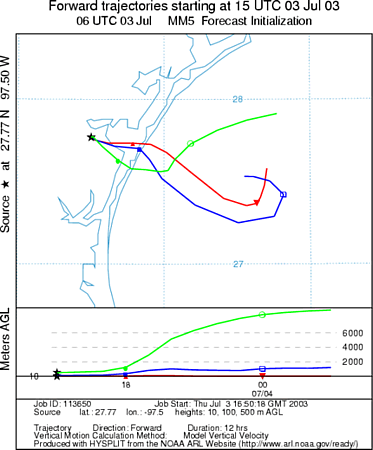 |
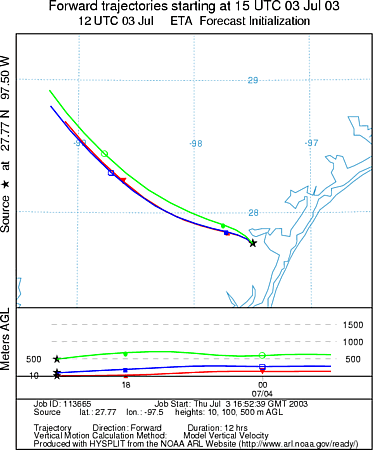 |
NOTE: Click on the underlines words to look at the trajectory and concentration graphic tutorials on the READY website if you are unfamiliar with such graphics.
First, we will look at the 12-hour forward trajectory forecasts starting at Corpus Christi, TX at 15 UTC 3 July 2003, starting at 10, 100, and 500 meters above ground level, which are shown below. The MM5 is completely out-of-directional-phase with the Eta model.
Below the plan view of the trajectories from each model is the vertical position of the parcel being followed as a function of time. Each model produces different results. The MM5 indicates significant venting (the 500-m parcel winds up at about 10-km above the surface) and the Eta-12 is fairly steady with some indication of lifting with height for the lower two trajectories. The RUC, on the other hand, indicates sinking after 18 UTC 3 July with all two trajectories near the ground from about 22 UTC on.
Figure: 12-hour forward trajectories from Corpus Christi, TX at 10, 100, and 500-m starting from 15 UTC 3 July for (from left to right) the MM5, RUC, and operational Eta-12. Below the plan views are height of parcels followed in the trajectories as a function of time. The 18 UTC 3 Jul and 00 UTC 4 July positions are highlighted. Note that each diagram has different horizontal and vertical scaling from the other because of the differing trajectory locations.
 |
 |
With such different trajectories, the pollutant concentration plumes can also be expected to differ signficantly. This is indeed the case, as we can see in these graphics. The MM5 animation shows little movement of the plume, with initially high concentrations, but subsequent rapid dissipation corresponding with the vertical rise of the 500-m trajectory after 18 UTC. In fact, the plume forced with MM5 data is undetectable after 21 UTC. Other possible explanations for decreased concentrations in the MM5 will be discussed later.
Figure: Time-animated graphics of plume of pollutant concentrations from same starting location as the trajectory plots for (from left to right) the MM5 and operational Eta-12. The source is in a line from 10 to 100 meters, with a 3-hour emission at 1 unit of pollutant per hour at 15 UTC 3 July 2003. Concentrations are two-hour averages for the layer between 0 and 500 meters above the surface through 03 UTC 4 July 2003. Removal by settling, precipitation and cloud water is emulated, with the same removal rates for all runs. Map and concentration scales are different in each graphic.
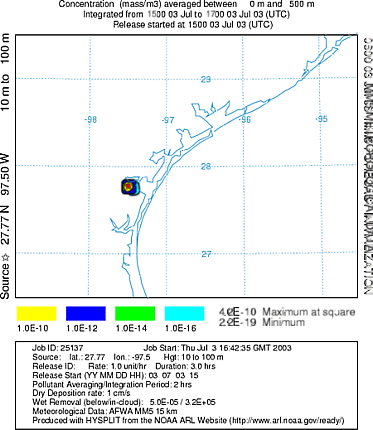 |
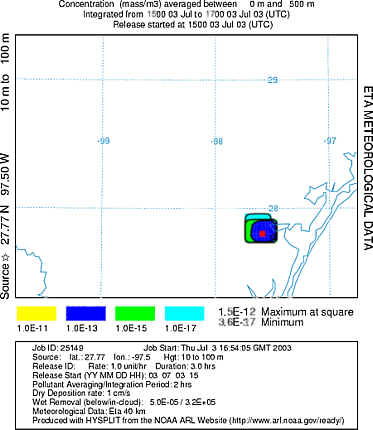 |
Locations where a pollutant is deposited can be as (or more) important as the downwind location of the concentration plume. The forecast deposition by the HYSPLIT using the two model sets of meterological data are shown below. The deposition is consistent with the concentration forecasts. The run forced with MM5 data shows all the pollutant being deposited near the source within the first few hours. On the other hand, the Eta show a spreading deposition trail from the source to the northwest, following the prevailing winds indicated in both the trajectories and the plume graphics.
Figure: Same as above, for deposition amounts over the same 12-hour period, for (from left to right) the MM5 and operational Eta-12. Note that map and deposition amount scales are different in each graphic.
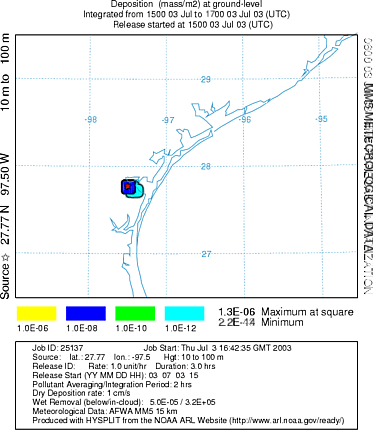 |
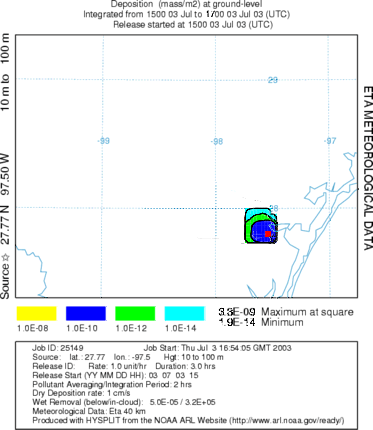 |